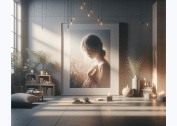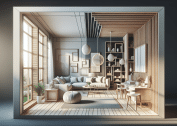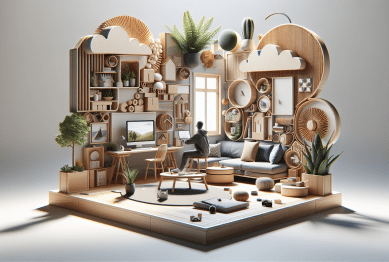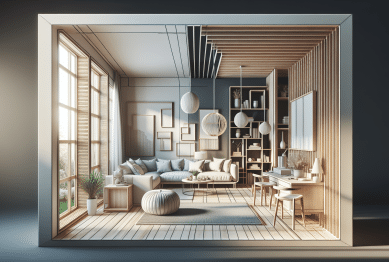Transform your space with easy home decor ideas you may not have considered before. This guide explores creative, affordable, and satisfying approaches to freshening up your interiors—perfect whether you’re a first-timer or an enthusiastic decorator seeking new inspiration.
Enhancing Spaces with Natural Light
Natural light can transform any room, boosting both mood and atmosphere. Consider adjusting your layout so seating areas bask in daylight, maximizing warmth and vibrancy. Mirrors placed strategically across from windows amplify sunlight, doubling brightness for little effort. This method works in tight apartments and spacious homes alike, making living spaces feel welcoming. Even simply cleaning windows and removing heavy curtains enhances natural light. Small choices, remarkable results.
Natural illumination doesn’t only brighten interiors—it helps save on energy bills and is linked to greater well-being. According to interior design experts, plenty of sunlight creates the illusion of more space and highlights the true color of your chosen decor. Accent pieces, such as transparent vases or metallic frames, can further reflect natural rays, adding more dimension. Take note of how the sun shifts throughout the day and plan your use of sheers, blinds, or shades for the ideal balance.
Those concerned with privacy need not block out all the sun. Frosted films, indoor plants, or semi-transparent textiles soften views from outside but still permit gentle light. This technique is especially useful if your living area faces a busy street or neighboring buildings. Don’t underestimate accessories like glass tabletops or pale-colored rugs. Their surfaces bounce light deeper into rooms, creating a bright backdrop for daily living. Simple shifts, radiant impact.
Color Palettes That Influence Mood
Choosing the perfect color palette anchors your home decor and directly influences how rooms feel. Soft blues and gentle greens have a calming effect, perfect for bedrooms and quiet nooks. Warm tones like ochre or muted pinks promote comfort and connection, making them ideal for living and dining spaces. Neutral backgrounds provide the flexibility to cycle in trendier accent hues, ensuring easy updates without major renovations. Color matters—it shapes the mood instantly.
Paint isn’t the only way to infuse color. Accessories such as pillows, throws, and art prints introduce pops of personality without overwhelming the space. For those hesitant about bold choices, start with small decor items and notice how they complement lighting and existing furnishings. Remember that even a single feature wall or a painted door can make a significant difference in energy and impression. Balance is key—a harmonious palette ties everything together.
Lifestyle blogs and ongoing design research suggest trying nature-inspired shades for a timeless appeal. Earthy and botanical tones offer a soothing sense of balance, while deeper jewel colors bring luxury and depth. Test samples before committing and observe colors at different times of day, as lighting can alter perception. Your home’s palette should ultimately reflect your personality and energy, acting as a backdrop for both everyday routines and special moments.
Creative Uses for Everyday Objects
Home decor isn’t limited to store-bought accents; ordinary household items can bring unexpected charm to your rooms. Mason jars and vintage tins become vases or candle holders. Books stacked on coffee tables double as conversation pieces and subtle color elements. Scarves or fabric remnants turn into unique table runners or wall hangings, giving a creative touch without extra expense. The key is experimentation—see familiar items with fresh eyes for a sustainable approach to decorating.
Upcycling has gained popularity for both its environmental benefits and its potential for customization. Old ladders make excellent blanket racks, and wooden crates can transform into open shelving. These projects require minimal tools and invite personal flair, making them especially satisfying for DIY enthusiasts. Check online forums and home decor guides for step-by-step inspiration on turning leftovers into standout design elements—often, the result is trendier and more personal than store-bought goods.
The best part about repurposing everyday items is their versatility. Trays used for serving drinks can also gather perfumes or jewelry on a dresser. Baskets tucked under coffee tables keep clutter at bay while also contributing texture. Think beyond each object’s original purpose and combine pieces from different rooms. This approach not only personalizes your space but fosters a sense of resourcefulness—something that never goes out of style.
Mindful Decor: Minimalism Meets Comfort
Minimalism is more than an aesthetic—it’s a lifestyle shift that values simplicity and intention. Decluttering surfaces and focusing on a few meaningful objects creates a calmer, more open environment. However, minimal doesn’t mean stark. Soft textiles, cozy throws, or layered rugs make rooms inviting without visual clutter. Choose furniture with hidden storage or multi-use features to maintain a neat, spacious vibe. Less often feels like more when each piece is selected thoughtfully.
Recent trends favor blending minimalism with comfort, sometimes called ‘warm minimalism.’ Natural textures, such as linen or wood, counterbalance clean lines and neutral color schemes. Plants, in particular, soften the look and help purify indoor air. Arranging belongings in intentional groupings or vignettes avoids a museum-like coldness. The guiding principle: only display what you love or use regularly. Everything else can be stored out of sight, so peace reigns over chaos.
Adopt a mindful approach to purchases by asking if each addition brings joy or serves a function. Sustainable, responsibly crafted pieces, even if few, leave a lighter footprint. Choose quality over quantity and introduce subtle variety through cushions, baskets, or ceramics. Over time, this method leads to a home that is both elegant and incredibly comfortable—a personal retreat supporting whatever your day holds.
Affordable Art for Unforgettable Walls
Empty walls are opportunities in disguise. Not everyone has the budget for gallery pieces, but affordable wall art brings personality and story to any space. Consider framing postcards, favorite calendar pages, or children’s artwork for a curated effect. Photo galleries featuring personal milestones or nature snapshots add sentiment and visual impact. Removable wallpaper decals are another easy way to experiment with pattern and style without permanent commitment.
Online platforms and community art fairs provide access to unique creations by emerging artists at reasonable prices. Purchasing prints instead of originals keeps costs down. Mix and match sizes and frame styles, arranging art in a cluster for a dynamic gallery wall. If you enjoy making things, try abstract painting or collage—art doesn’t need to be ‘perfect’ to be meaningful. The goal is to create a space that resonates with your memories and dreams.
Even simple touches—like hanging woven baskets, mirrors, or decorative plates—break monotony and add tactile interest. Rotate art seasonally so your home’s decor feels fresh all year. Reflect on colors that make you feel happy or calm and let those guide your art selections. Wall decor is highly personal: it’s a collection of what brings you inspiration daily, not just a visual filler for blank space.
Green Living: Plants as Decor Essentials
Incorporating plants into home decor delivers style and practical benefits. Even the smallest potted succulent or trailing vine brings vitality and a connection to nature. Indoor gardening is friendly for beginners—start with resilient varieties like snake plants, pothos, or spider plants. Grouping plants on shelves or in clusters adds layered texture. Living greenery filters indoor air and can improve your mood. It’s decor that also makes you feel better every day.
Whether you have sprawling windowsills or just a tiny corner, there are options for everyone. Hanging planters, wall-mounted pots, and vertical gardens are clever choices for space-challenged homes. For those short on time or experience, self-watering pots and low-maintenance plants are great solutions. Designate a plant ‘zone’ in your kitchen or bath for fresh herbs or air-purifying ferns. Community gardening resources and online houseplant groups offer advice, troubleshooting, and camaraderie along the way.
Don’t forget the decorative impact of containers. Interesting planters—ceramic, metal, or even repurposed teacups—add personality. Larger specimens like fiddle-leaf figs or dracaena make striking room anchors. Move plants around to find the best light and composition. The result: a dynamic living display, and the satisfaction of nurturing something beautiful. Bringing nature inside isn’t just a trend—it’s a powerful way to create a restorative, happy home.
References
1. Environmental Protection Agency. (n.d.). Indoor Air Quality: Plants and Air Quality. Retrieved from https://www.epa.gov/indoor-air-quality-iaq/house-plants
2. American Psychological Association. (n.d.). How Colors Impact Mood and Behavior. Retrieved from https://www.apa.org/topics/color
3. Harvard University Graduate School of Design. (n.d.). Daylight and Health: Design Considerations. Retrieved from https://www.gsd.harvard.edu/research/features/daylight-health-design-considerations/
4. National Association of Home Builders. (n.d.). The Value of Natural Light in Home Design. Retrieved from https://www.nahb.org/advocacy/industry-issues/sustainability-and-green-building/the-value-of-natural-light
5. Smithsonian Magazine. (2021). The Science of Minimalism: Declutter for a Happier Home. Retrieved from https://www.smithsonianmag.com/innovation/does-decluttering-really-make-you-happier-180972275/
6. The Spruce. (n.d.). Decorating with Plants: Ideas and Inspiration. Retrieved from https://www.thespruce.com/decorating-with-houseplants-5079768









